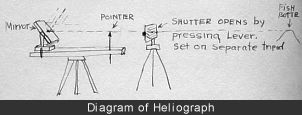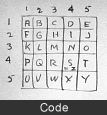| Chapter 11: The
Heliograph
 One of my duties was to
relay messages from Willis, a man stationed on Fish Butte. He was across
the Locksaw River, 13 to 15 miles away as the crow flies, with a valley
a mile deep between, bottomed by a raging river. He had no telephone; so
we had to communicate by heliograph. One of my duties was to
relay messages from Willis, a man stationed on Fish Butte. He was across
the Locksaw River, 13 to 15 miles away as the crow flies, with a valley
a mile deep between, bottomed by a raging river. He had no telephone; so
we had to communicate by heliograph.
A heliograph is a
mirror about 4" square which reflects the sun's rays toward the
station desired. There is no limit of distance, as long as both points
are visible. Willis talked with Graves Peak 80 miles away.
The set-up is as
follows:

The silver is removed
from the center of the mirror, about 1/8" dia. The mirror is
pivoted vertically and horizontally, and a pointer which has vertical
adjustment is located as shown. Looking through the unsilvered spot as a
peep-sight and over the pointer to the station to be contacted, the
assembly is clamped. In line with the direction desired, set up the
shutter as close to the pointer as practicable. The mirror is then
adjusted until the reflected light is directed on the white shutter.
When the shadow of the unsilvered spot appears just over the pointer, we
know that the ray is centered on our target. Frequent adjustment of the
mirror is essential, and the alignment must not be disturbed.
 As the Morse code has
long and short dashes, a simplified code was adopted, in which all
dashes are alike. The alphabet is divided into coordinates. The letter
"Z" is omitted. As the Morse code has
long and short dashes, a simplified code was adopted, in which all
dashes are alike. The alphabet is divided into coordinates. The letter
"Z" is omitted.
The dashes correspond
with the numbers in the margin, the vertical column being given first.
Thus the word "ham" would be indicated as follows:
---
-- - - --- ---
We used the code the
first day and had no trouble to speak of. We also had an abbreviated
code -- i.e. A-D-G might mean "bring grub," etc. We had
numbers which I may find later, but have lost.
|